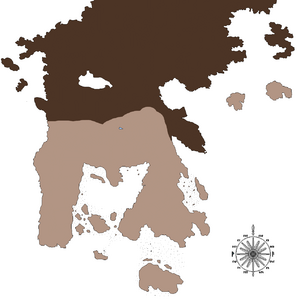Scanderan Shagrat
| Scanderan Shagrat | |
|---|---|

| |
| a picture of a large shagarth | |
| Scientific classification | |
| Kingdom: | Animalia
|
| Phylum: | Chordata
|
| Class: | Mammalia
|
| Order: | Rodentia
|
| Family: | Sciuridae
|
| Genus: | Marmota
|
| Species: | M.Tyrannos
|
| Binomial name | |
| Marmota Tyrannos Hylfred Görenssen, 1785
| |

| |
| Dark brown: Habitat, light brown: Habitat where the shagart has been introduced. | |
Despite it's latin name so is the Shagart a rather mild tempered creature unless provoked that originated from the large plains, forests and tundra of the northern iceplains. However so is it also with deers and rabbucks often considered the chief pray for several of the larger animals that lives on the northern iceplains which have evolved it into a very fast animal that can not only keep up with a horse, and overtake it in some cases, but also keep running for long periods of time.
It is also one of the first Scanderan animals that were domesticated and large herds of the animals have been kept by human tribes even before the human migrations and once they migrated south did they take their shagrats with them.
Etymology
It is unknown where the name shagrat comes from or what it means and some have theorised that it might be an old dwarven, troll or goblin word from an old language long since forgotten while other says it comes from the legendary civilisation in isarna that sank with the land around them while other even claims that it is an Wharen word that was borrowed by Scanderan humans before the conflict between the wharen and the northern species arose.
History
Historically so have Sharats had great importance for the Scanderan peoples as they were amongst the prime source of food for early tribes that lived entirely by moving around with their herds of deer, shagarths, goat and sheep and tribes often raided one another for shagarts and other resources just as a tribe's wealth was measured in warriors, wolves and shagarths.
From the shagarth did these early Scanderan nomadic people get meat, milk and furs that they made into armour and clothes. When they later on migrated south into the Vedian mountains and then down into Imeriata proper and Erathia so did they bring these animals with them that escaped and became feral again in the large dark forests of the south.
In Jarnara for instance so are the shagarth still the largest landliving mammal that lives there wild.
In primitive Scanderan warfare so was also Shagrats one of the things that one fought over and it was mostly fought through raids where one tribe attacked the other and rode back home with their foes shagrats, deers, goats and sheep. Even in later ages so did this tradition lives on and in the ages that followed so was it common for the loser of a conflict to be forced to hand over a group of shagarts in addition to the other terms.
Taxonomy
There are several races of the shagrat that were all covered in Hylfred Görenssen's di landlevande varelserna and due to the extensive breeding of them so can a shagart be as varied in appearance as dogs can be however the most well known races is the wild shagrat, aster shagraten from asterarna, berga shagrat from vedian and sydan shagrat that were breed in sundet, however so are there several breeds that are indigenous to very small areas as well.
Anatomy and health
Despite it's chubby and fuzzy appearance with it's short legs so is the shagrat a remarkably quick runner that can keep up with a horse and can maintain speeds for long period of time which enables it to outrun most of it's predators. As most animals in the northern iceplains so is it covered in a thick coat of fur that grows thicker and white in winter to help it not only withstand the cold but also to camouflage easier amongst the snow covered winterland.
It is also outfitted with a pair of long sharp teeth that it uses not only to bite off smaller trees and grass to feast with but it also digs up roots. Another more famous usage of it's long sharp teeth is to defend itself as the males are often known to engage predators that they cannot outrun and it is not undocumented that unsuspecting wolves, ratwolves and even horsewolves that thought they had separated a lonely individual became prey to it's own tactics as the predator gets swarmed.
Reproduction
The Shagrat is a species with a high reproduction rate to replace the numerous animals that fall prey every year. However a female gives birth to a large litter of up to seven shagrats cubs after only 3 months and often births two litters a year. To signal that she is willing to mate does the female whistle through her nose to let the rest of the animal in the large herd know that she is ready to mate where she either declines males that wish to mate or allows them to do so depending on their rank in the herd.
Diet
The shagrat is a herbivore and often are found either on the woodfloor or on the large plains of the northern iceplains where it tends to eat grass, roots, berries and shrubberies which have put it to conflict with farmers as the wild Shagrats are known to eat up harvests just as they have been known to devour small tree for tree plantations.
Behaviour
The shagrat is a highly social animal that lives in large herds and are more than often known to cuddle up with other individuals to build trust and to keep warm on the frozen plains and shagrat herds have been known to cuddle up with their pack in the winter months in one of the large so called "shagrat hus" or "shagrat house" that they often build by crawling up to one another tightly during night.
This means that the animal is very loyal and trusting once it has gotten used to an individual as part of the herd and even large horsewolves used for riding by the herders have been known to be accepted even if they needs to be raised with the herd to allow this to happen.
Once startled however so does the herd start to run while a small group consisting of the leading male and the larger males circle the herd to shield it from dangers and even attack predators with their sharp and powerful jaws which can be fatal and it is not uncommon to see both dead shagrats and predators with shattered bones from the powerful bite of the rat that took out the attacker with his own life.
Life expectancy
A shagrat can grow to be as old as twelve in captivity even if it tends to die much younger than that in the wild due to predator attacks, disease and cold.
